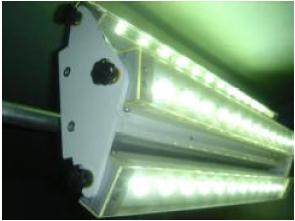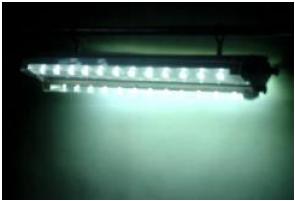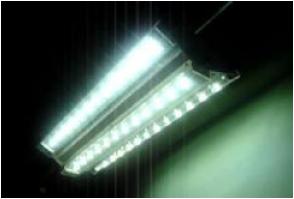|
The BINAY model ‘Universa-TL’ PowerLED Strip Light
Luminaire is a long-life, power-saving luminaire designed to replace
T-5 and T-8 fluorescent tube lights, and is ideal for locations
requiring continuous 24x7 operation
The BINAY model Universa-TL PowerLED Strip Light luminaire
is available in 2-, 3- and 4-feet lengths, each with options of one,
two or three LED light bars (strips) of heat-sinking aluminium. Each
bar is axially adjustable, allowing the user to direct the light
output as desired.
Each
2’ light bar has 12 Power LEDs running at 350mA. Similarly, each 3’
bar has 21 LEDs, and the 4’ bar has 30 LEDs. The luminaire fitting
can be supplied with configurations of one, two or all three light
bars.
All the high power LEDs are silicone-encapsulated to
ensure long life with minimal light degradation over time. They can
be of two intensities, 50 lumens per watt, or high intensity 120
lumens per watt. At the maximum
configuration (4 feet luminaire
with 3 bars), the design can radiate up to
12,000 lumens at a
power consumption of only 125 watts.
Designed for universal
90V-260VAC operation through an in-built SMPS driver, it can also be
manufactured in 12VDC, 24VDC, and 48VDC ratings for battery
operation. The SMPS driver ensures steady light output
even with
input voltage variation, unlike fluorescent
tubes.
All-aluminium construction in the luminaire ensures a
corrosion-resistant body, thus matching the LED life of 10 to 30
years (50,000 hours to 30% lumen depreciation and 100,000 hours to
50% lumen depreciation). Standard finish is powder-coated white, but
it can be supplied in anodised natural silver or black finish
against special order. Fixing method can by chain or rod for pendant
hanging (for ceiling installation), or surface-mount
with a
fixing plate (for fixing to ceilings or walls).
This product
is an ideal replacement for T-5 and T-8 fluorescent tubes, which
consume high power, contain environmentally hazardous mercury, and
have light output which is highly dependent on ambient
temperature
(while the optimal light output of fluorescent tubes
occurs at 30°C, it depreciates greatly – by up to 60% – at 10°C).
The system efficiency is also higher, being more than 95% due to the
180° directivity property of LEDs (in contrast to 50-70% with that
of conventional light sources, which radiate light 360° all around
and require a wasteful reflector to direct the light in the
direction required).
FEATURES
High
system efficiency and low power consumption (50% saving in power
over equivalent fluorescent tube lighting)
Long
useful life (50,000 - 100,000 hours)
Vibration-resistant and shock-proof
Light
dispersion completely adjustable, from direct task lighting too wide
dispersion for general lighting
An
ecologically friendly product, and contributes to the reduction of
global warming; is a factor to to “Green” building
certification
Can
be easily dimmed (or some light bars turned off when desired at
select times, by means of a timer)
Can
be operated on 12VDC battery supply on mains power failure with
external battery-inverter/UPS system
Available in cool white (2500°K - 5500°K), natural white
(3500°K - 4500°K) or warm white (2500°K - 3500°K) (NOTE: Maximum
light output occurs with cool white.)
Colour Rendering Index of 75-80 (higher with warm
white)
More
light at low temperature (diametrically opposite to fluorescent tube
characteristics)
No
ultra violet radiation – avoids colour fading;
No
infrared radiation – does not create any load on air conditioning
systems.
SOME
APPLICATIONS
Low bay industrial lighting (for ceiling heights less than 25
feet/7.5 meters)
Covered parking garages – ceiling or wall mounting luminaires
which require to be lighted on a 24x7 basis
Service areas and basements in hotels and hospitals, which
require continuous 24x7 lighting
Cold storage lighting: Provides more light at low temperatures
(even at 0°C)
Warehouse lighting – better colour discrimination and visual
perception than with HPSV (sodium) lamps
General corridor lighting in commercial buildings.
With
LED lighting, while initial capital cost is at present high, total
lifetime cost of ownership is much lower due to the light being
maintenance-free. It is not plagued with the problems of frequent
replacement, thus eliminating inventory cost and labour costs of
replacement maintenance. The lower power consumption also makes LED
luminaires ideal for operation
on alternative power supply
sources such as diesel generators or battery-inverter/UPS
supplies.
LED LUMEN OUTPUT FOR VARIOUS CONFIGURATIONS OF
UNIVERSA-TL Scotopic/Photopic lumen adjustment multipliers: MH/PS x
1.49; HPSV x 0.62; 6500˚K LED x 2.14*
|
 |
 |
 |
 |
BINAY
UNIVERSA-TL
(IN 2ft. 12-LED BAR x 3
CONFIGURATION) |
| | |